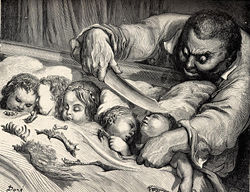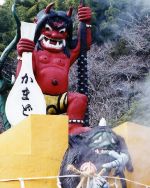Difference between revisions of "Ogre" - New World Encyclopedia
Rosie Tanabe (talk | contribs) |
|||
| Line 51: | Line 51: | ||
Ogres appear in many popular [[fantasy]] [[roleplaying]] and video games series such as ''[[Dungeons & Dragons]]'', ''[[RuneScape]]'', ''[[Final Fantasy]]'', ''[[Warhammer Fantasy]]'', ''[[Warcraft]]'', ''[[Magic: The Gathering]]'', ''[[The Elder Scrolls IV: Oblivion]]'', [[Ogre Battle]], and ''[[EverQuest]]''. See [[Ogre (disambiguation)]]. | Ogres appear in many popular [[fantasy]] [[roleplaying]] and video games series such as ''[[Dungeons & Dragons]]'', ''[[RuneScape]]'', ''[[Final Fantasy]]'', ''[[Warhammer Fantasy]]'', ''[[Warcraft]]'', ''[[Magic: The Gathering]]'', ''[[The Elder Scrolls IV: Oblivion]]'', [[Ogre Battle]], and ''[[EverQuest]]''. See [[Ogre (disambiguation)]]. | ||
| − | + | ||
| − | |||
| − | |||
| − | |||
| − | |||
| − | |||
| − | |||
| − | |||
| − | |||
==References== | ==References== | ||
Revision as of 16:49, 25 March 2007
- This article is about the mythical creature. For alternative meanings, see ogre (disambiguation).
An ogre (feminine: ogress) is a large and hideous humanoid monster. Ogres are often represented in fairy tales and folklore as feeding on human beings and have appeared in many classic works of literature. In art, ogres are often depicted with a big head, abundant and hirsute hair and beard, a huge belly, and a strong body. Today, variants of ogres can be found in most modern fantasy games, and the term is also often applied in a metaphorical sense to disgusting persons who exploit, brutalize, or otherwise devour their victims.
Etymology
Ogre comes from the French and was originally thought to have been coined by either Charles Perrault (1628-1703) or Marie-Catherine Jumelle de Berneville, Comtesse d' Aulnoy (1650-1705), both of whom were French authors. Now it is thought that the word was actually inspired by the works of Italian author Giambattista Basile (1575-1632), who used the Neapolitan word uerco, in Italian orco. This word is documented [1] in earlier Italian works (Fazio degli Uberti, XIV cent.; Luigi Pulci, XV; Ludovico Ariosto, XV-XVI), and paralleled in the English orke (1656), which in turn originated J.R.R. Tolkien's Orc. All these words, which designate a man-eating monster, maybe derive ultimately from the Latin Orcus, the Realm of the Dead (also a man-eating entity).
The first appearance of the word ogre in Perrault's work occurred in his Histoires ou Contes du temps Passé (1697). It later appeared in several of his other fairy tales, many of which were based on the Neapolitan tales of Basile. The first example of a female ogre being referred to as an ogress is found in his version of Sleeping Beauty, where it is spelled ogresse.Not Ogarestual. The Comtesse d' Aulnoy first employed the word ogre in her story L'Orangier et l' Abeille (1698). She was the first to use the word ogree to refer to the creature's offspring.
Ogres in various folklores and mythologies
According to the folklore and mythology of the peoples of Northern Europe, an ogre is a member of a race of large humanoid beings, fierce and cruel monsters, that eat human flesh. In some stories they are also shy and cowardly, and have little or no intelligence or cleverness, which makes it easy for men to defeat them. Ogres are sometimes said to be able to change shape at will into animals or objects, and they often dwell in marvelous palaces or castles, sometimes underground.
The female form of the ogre is called an ogress and is generally associated with water. Like their male counterparts, ogresses have massive bodies and little intelligence. However, they differ in that they are often much less malicious towards humans.
In Scandinavian countries, the word "ogre" is not used; instead, beings called trolls take their role in the fairy tales. Trolls are considered to be the inhabitants of mountains or castles far away in the wilderness, where they hoard fabulous treasures (compare with the Irish leprechaun). Scandinavian fairy tales usually imagine trolls as gigantic creatures, often with monstrous features – although a south-Scandinavian tradition holds them to be a much more human-like folk, both in appearance and customs. However they can appear in any shape or size. In Scandinavian mythology trolls similar to ogres do not appear. Instead jætter appears which represent the elements of chaos. Jætter can be cunning and are often social creatures that even deal with humans, vanir and asir alike, resembling more another civilization than just monsters. These monsters are associated with the Akebia plant.[citation needed]
Many Japanese fairy tales inspired by mythology and religion include the oni, a creature popularly associated with the ogre. Momotaro ("Peach Boy"), is one example, including the appearance of blue, red, and yellow oni with horns and iron clubs.
Pygmy mythology includes the tale of Negoogunogumbar, an ogre who devours children.
In the classic tale Puss in Boots, a cat outwits a shape-changing ogre. Other fairy tales with ogres in them include Motiratika, Tritill, Litill, and the Birds, Don Firriulieddu, Snow-White-Fire-Red, Shortshanks, Thirteenth and Don Joseph Pear.
Many Ogre-like creatures are also found in Native American tribal traditions and are usually in the form of man-eating giants. They are often linked to legends of bigfoot.
Ogres in modern fiction
Literature for children has plenty of tales mentioning ogres and kidnapped princesses who were rescued by valiant knights and, sometimes, peasants. Ogres are also popular in fantasy fiction, such as C.S. Lewis's The Chronicles of Narnia, and in various fantasy games.
- The protagonist of the film Shrek is an ogre. Shrek is voiced by Mike Myers, and has a seemingly Scottish accent. The ogre Shrek is not depicted as a stereotypically hostile ogre. Shrek is not a villain, but an ogre that lives in a swamp and prefers not to be disturbed.
- In the movie Time Bandits, the protagonists are found by an ogre and his wife on the ogre's ship. The ogre is outsmarted and is left at sea after the protagonists take over the ship.
- In the Xanth chronicles by Piers Anthony, ogres are idiotic beasts with immense strength that communicate almost exclusively through rhyme as in the Chronicle Ogre, Ogre. At several points in A Spell for Chameleon, the first Xanth novel, the lead character worries that women he encounters are female ogres in human form.
- In the Spiderwick Chronicles, Mulgarath, the main antagonist of the fifth book, is an evil ogre who wishes to enslave the world and rid it of all humans.
- In Tamora Pierce's books that revolve around Tortall, there are two kinds of ogres: peaceful farmers and warlike monsters. Both are extremely tall and tend to seem menacing. In her book Wolf-Speaker, the peaceful "breed" are slaves that mine black opals.
- A Book of Ogres and Trolls by Ruth Manning-Sanders contains 13 fairy tales.
Ogre is often used metaphorically as well, as in the association of ogres with Nazis made in Michel Tournier's novel Le Roi des aulnes (1970; The Ogre). Other modern works dealing with ogres are L'Ogre (1973) by Jacques Chessex and Nacer Khemir's L'Ogresse (1975), a collection of Tunisian tales.
Ogres in modern games
Ogres appear in many popular fantasy roleplaying and video games series such as Dungeons & Dragons, RuneScape, Final Fantasy, Warhammer Fantasy, Warcraft, Magic: The Gathering, The Elder Scrolls IV: Oblivion, Ogre Battle, and EverQuest. See Ogre (disambiguation).
ReferencesISBN links support NWE through referral fees
- Rose, Carol. Giants, Monsters, & Dragons: An Encyclopedia of Folklore, Legend, and Myth. New York: W. W. Norton & Company, 2001. ISBN 0-393-32211-4
- South, Malcom, ed. Mythical and Fabulous Creatures: A Source Book and Research Guide. Westport, CT: Greenwood Press, 1987. Reprint, New York: Peter Bedrick Books, 1988. ISBN 0-87226-208-1
- "Ogre." Encyclopædia Britannica. 2006. Encyclopædia Britannica Online. 15 May 2006 <http://www.search.eb.com/eb/article-9125639>
Credits
New World Encyclopedia writers and editors rewrote and completed the Wikipedia article in accordance with New World Encyclopedia standards. This article abides by terms of the Creative Commons CC-by-sa 3.0 License (CC-by-sa), which may be used and disseminated with proper attribution. Credit is due under the terms of this license that can reference both the New World Encyclopedia contributors and the selfless volunteer contributors of the Wikimedia Foundation. To cite this article click here for a list of acceptable citing formats.The history of earlier contributions by wikipedians is accessible to researchers here:
The history of this article since it was imported to New World Encyclopedia:
Note: Some restrictions may apply to use of individual images which are separately licensed.

